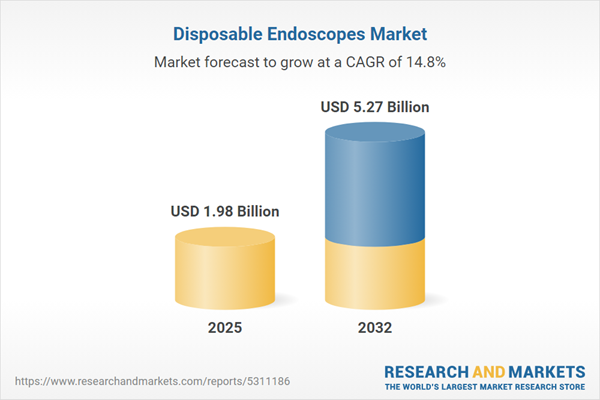Speak directly to the analyst to clarify any post sales queries you may have.
The disposable endoscopes market is undergoing rapid transformation as healthcare systems seek safer, more efficient diagnostic and therapeutic solutions. Driven by infection control needs and technological advancement, single-use devices are gaining traction across global clinical settings.
Market Snapshot: Disposable Endoscopes Market Overview
The Disposable Endoscopes Market grew from USD 1.75 billion in 2024 to USD 1.98 billion in 2025. It is expected to continue growing at a CAGR of 14.76%, reaching USD 5.27 billion by 2032. Consistent adoption is supported by the sector’s ability to address both cross-contamination risks and operational efficiency, while market participants pivot to respond to regulatory and cost frameworks worldwide.
Scope & Segmentation
This report provides a comprehensive evaluation of the disposable endoscope sector, covering technology trends, segment dynamics, and the evolving landscape of procurement and clinical use. The scope encompasses a multi-dimensional assessment including:
- Product: Bronchoscopes, Colonoscopes, Duodenoscopes
- Type: Flexible Endoscopes, Rigid Endoscopes
- Application: Arthroscopy, Bronchoscopy, ENT Endoscopy, Gastrointestinal Endoscopy, Urologic Endoscopy
- End-User: Ambulatory Surgical Centers, Diagnostic Centers, Hospitals & Clinics
- Distribution Channel: Direct Sell, Online
- Region: Americas (North America - United States, Canada, Mexico; Latin America - Brazil, Argentina, Chile, Colombia, Peru), Europe, Middle East & Africa (Europe - United Kingdom, Germany, France, Russia, Italy, Spain, Netherlands, Sweden, Poland, Switzerland; Middle East - United Arab Emirates, Saudi Arabia, Qatar, Turkey, Israel; Africa - South Africa, Nigeria, Egypt, Kenya), Asia-Pacific (China, India, Japan, Australia, South Korea, Indonesia, Thailand, Malaysia, Singapore, Taiwan)
- Key Companies: 3NT Medical, Inc.; Altek Corporation; Ambu A/S; B. Braun Melsungen AG; BioVision Technologies, LLC by ATL Technology, LLC; Boston Scientific Corporation; Daichuan Medical (Shenzhen) Co., Ltd; Dyne Medical Group; EnlightenVue, Inc.; Flexicare Medical Limited; Fujifilm Holdings Corporation; Hill-Rom Holdings, Inc.; Integrated Endoscopy; Intersurgical Ltd.; IQ Endoscopes Limited; J-Sol Medical Co., Ltd.; Karl Storz SE & Co. KG; NeoScope, Inc.; Olympus Corporation; OTU Medical Inc.; Parburch Medical Developments Ltd; PENTAX Medical; Scivita Medical Technology Co., Ltd.; STERIS Corporation; Teleflex Incorporated; The Cooper Companies, Inc.; The Surgical Company; Verathon Inc. by Roper Technologies, Inc.; Zhejiang Geyi Medical Instrument Co., Ltd.; Zsquare Ltd.
Key Takeaways for Senior Decision-Makers
- Single-use disposable endoscopes are now prioritized in clinical workflows for their ability to simplify infection control and reduce sterilization complexity.
- Technological advancements have resulted in single-use devices with high-definition imaging and enhanced material integrity, supporting consistent performance across diverse procedures.
- Market players are leveraging strategic alliances and digital integrations to strengthen supply chain efficiency and offer holistic endoscopic solutions to healthcare providers.
- Environmental sustainability is increasingly shaping product engineering and recycling programs, aligning disposable device adoption with corporate responsibility mandates.
- Procurement priorities are shifting toward lifecycle analysis, driving the need for value propositions that balance device cost with operational and safety benefits.
- Regional adoption patterns are influenced by reimbursement policies, infrastructure maturity, and regulatory frameworks, generating unique opportunities and challenges across global markets.
Tariff Impact and Supply Chain Considerations
Proposed tariffs set for implementation in the United States in 2025 introduce new cost variables for import-dependent distributors. This is prompting manufacturers to evaluate nearshoring and alternative sourcing strategies, which could temporarily disrupt existing supply chains. Healthcare providers will likely intensify total cost of ownership evaluations, seeking strategic supplier relationships and improved trade compliance to manage procurement risks.
Methodology & Data Sources
This analysis synthesizes structured interviews with clinical leaders and procurement managers, validated through reviews of technical publications, regulatory filings, and trend analyses. Quantitative models assess adoption rates and cost structures, while qualitative case studies reveal real-world best practices and operational challenges.
Why This Report Matters
- Gain a detailed understanding of evolving competitive dynamics and regulatory shifts shaping market entry strategies.
- Utilize actionable segmentation insights to optimize product positioning and target emerging growth opportunities in key regions.
Conclusion
The disposable endoscopes market offers a dynamic landscape driven by advances in infection control, digital integration, and evolving regulatory standards. Informed by robust research and segment-specific trends, this report serves as a strategic guide for senior leaders navigating a complex and growth-oriented sector.
Additional Product Information:
- Purchase of this report includes 1 year online access with quarterly updates.
- This report can be updated on request. Please contact our Customer Experience team using the Ask a Question widget on our website.
Table of Contents
3. Executive Summary
4. Market Overview
7. Cumulative Impact of Artificial Intelligence 2025
Companies Mentioned
The companies profiled in this Disposable Endoscopes market report include:- 3NT Medical, Inc.
- Altek Corporation
- Ambu A/S
- B. Braun Melsungen AG
- BioVision Technologies, LLC by ATL Technology, LLC
- Boston Scientific Corporation
- Daichuan Medical (Shenzhen) Co., Ltd
- Dyne Medical Group
- EnlightenVue, Inc.
- Flexicare Medical Limited
- Fujifilm Holdings Corporation
- Hill-Rom Holdings, Inc.
- Integrated Endoscopy
- Intersurgical Ltd.
- IQ Endoscopes Limited
- J-Sol Medical Co., Ltd.
- Karl Storz SE & Co. KG
- NeoScope, Inc.
- Olympus Corporation
- OTU Medical Inc.
- Parburch Medical Developments Ltd
- PENTAX Medical
- Scivita Medical Technology Co., Ltd.
- STERIS Corporation
- Teleflex Incorporated
- The Cooper Companies, Inc.
- The Surgical Company
- Verathon Inc. by Roper Technologies, Inc.
- Zhejiang Geyi Medical Instrument Co., Ltd.
- Zsquare Ltd.
Table Information
| Report Attribute | Details |
|---|---|
| No. of Pages | 195 |
| Published | November 2025 |
| Forecast Period | 2025 - 2032 |
| Estimated Market Value ( USD | $ 1.98 Billion |
| Forecasted Market Value ( USD | $ 5.27 Billion |
| Compound Annual Growth Rate | 14.7% |
| Regions Covered | Global |
| No. of Companies Mentioned | 31 |









